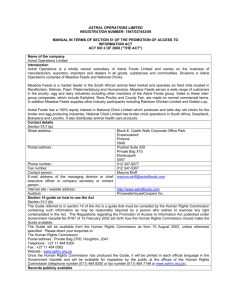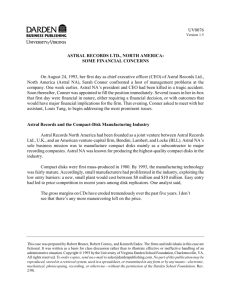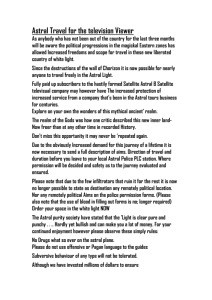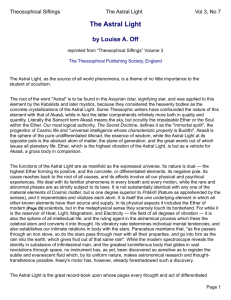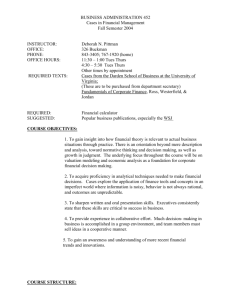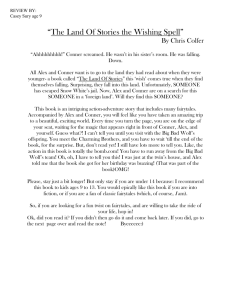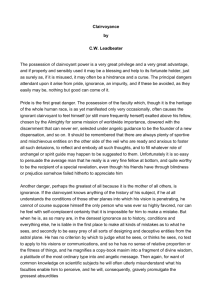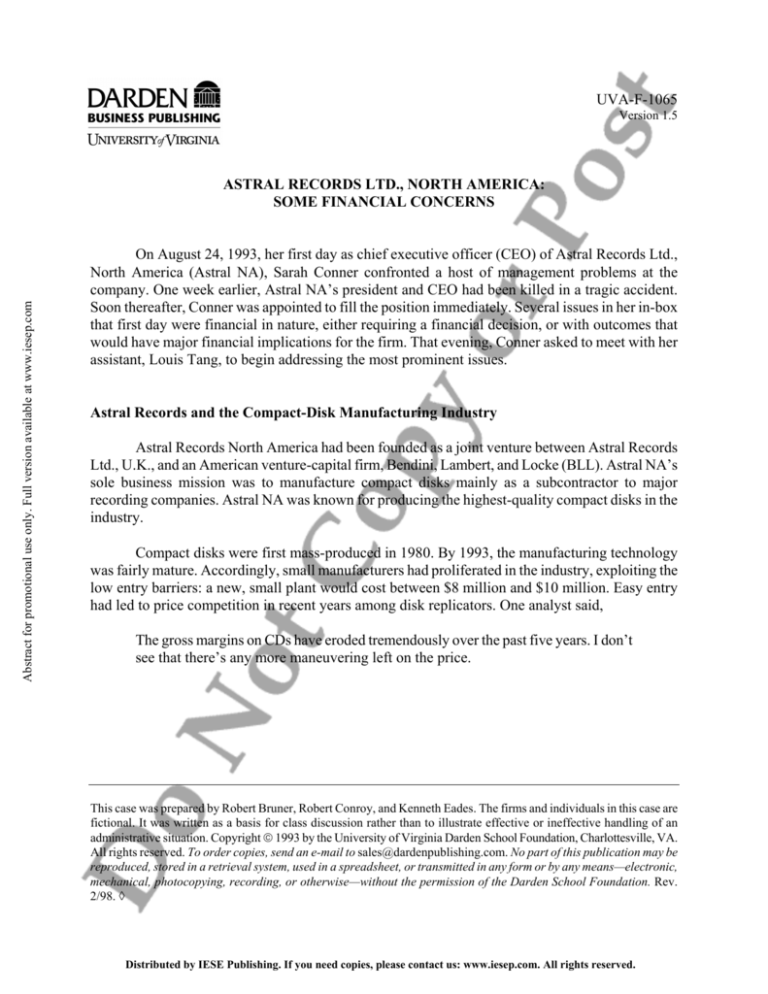
UVA-F-1065
Version 1.5
Abstract for promotional use only. Full version available at www.iesep.com
ASTRAL RECORDS LTD., NORTH AMERICA:
SOME FINANCIAL CONCERNS
On August 24, 1993, her first day as chief executive officer (CEO) of Astral Records Ltd.,
North America (Astral NA), Sarah Conner confronted a host of management problems at the
company. One week earlier, Astral NA’s president and CEO had been killed in a tragic accident.
Soon thereafter, Conner was appointed to fill the position immediately. Several issues in her in-box
that first day were financial in nature, either requiring a financial decision, or with outcomes that
would have major financial implications for the firm. That evening, Conner asked to meet with her
assistant, Louis Tang, to begin addressing the most prominent issues.
Astral Records and the Compact-Disk Manufacturing Industry
Astral Records North America had been founded as a joint venture between Astral Records
Ltd., U.K., and an American venture-capital firm, Bendini, Lambert, and Locke (BLL). Astral NA’s
sole business mission was to manufacture compact disks mainly as a subcontractor to major
recording companies. Astral NA was known for producing the highest-quality compact disks in the
industry.
Compact disks were first mass-produced in 1980. By 1993, the manufacturing technology
was fairly mature. Accordingly, small manufacturers had proliferated in the industry, exploiting the
low entry barriers: a new, small plant would cost between $8 million and $10 million. Easy entry
had led to price competition in recent years among disk replicators. One analyst said,
The gross margins on CDs have eroded tremendously over the past five years. I don’t
see that there’s any more maneuvering left on the price.
This case was prepared by Robert Bruner, Robert Conroy, and Kenneth Eades. The firms and individuals in this case are
fictional. It was written as a basis for class discussion rather than to illustrate effective or ineffective handling of an
administrative situation. Copyright © 1993 by the University of Virginia Darden School Foundation, Charlottesville, VA.
All rights reserved. To order copies, send an e-mail to sales@dardenpublishing.com. No part of this publication may be
reproduced, stored in a retrieval system, used in a spreadsheet, or transmitted in any form or by any means—electronic,
mechanical, photocopying, recording, or otherwise—without the permission of the Darden School Foundation. Rev.
2/98. ◊
Distributed by IESE Publishing. If you need copies, please contact us: www.iesep.com. All rights reserved.
-2-
UVA-F-1065
Financial Questions Facing Sarah Conner
Abstract for promotional use only. Full version available at www.iesep.com
That evening, Conner met with Louis Tang, a promising new associate whom she had
brought along from BLL. Conner’s brief discussion with Tang went as follows:
Conner:
Back at BLL we looked at Astral as one of our most promising venture-capital
investments. Now it seems that such optimism may not be warranted—at least until
we get a solid understanding of the firm’s past performance and its forecasted
performance. Did you have any success with this?
Tang:
Yes, the bookkeeper gave me these: the historical-income statements (Exhibit 1) and
balance sheets (Exhibit 2) for the last four years. The accounting system here is still
pretty primitive. However, I checked a number of the accounts, and they look
orderly. So I suspect that we can work with these figures. From those statements, I
calculated a set of diagnostic ratios (Exhibit 3).
Conner:
I see that you have been busy. Unfortunately, I can’t study them right now. I need
you to review the historical performance of Astral NA for me, and to give me any
positive or negative insights that you think are significant.
Tang:
When do you need this?
Conner:
At 7:00 a.m. tomorrow. I want to call on our banker tomorrow morning to get an
extension on Astral’s loan.
Tang:
The banker, Farmington, said that Astral was “growing beyond its financial
capabilities.” What does that mean?
Conner:
It probably means that he doesn’t think we can repay the loan within a reasonable
period. I would like you to build a simple financial forecast of our performance for
the next two years (ignore seasonal effects) and show me what our debt requirements
will be at the fiscal years-ended 1994 and 1995. I think it is reasonable to expect that
Astral’s sales will grow at 15% each year. Use whatever assumptions seem
appropriate to you based on your historical analysis of the results. For this forecast,
you should assume that any external funding is in the form of debt.
Tang:
But what if the forecasts show that Astral cannot repay the loan?
Conner:
Then we’ll have to go back to Astral NA’s owners, BLL and Astral Records U.K.,1
for an injection of equity. Of course, BLL would rather not invest more funds unless
we can show that the returns on such an investment would be very attractive, and/or
1
Bendini, Lambert, and Locke owned a 60% interest in the equity of Astral NA. Astral Records Ltd., U.K., owned
the remaining 40% interest.
Distributed by IESE Publishing. If you need copies, please contact us: www.iesep.com. All rights reserved.
-3-
UVA-F-1065
Abstract for promotional use only. Full version available at www.iesep.com
that the survival of the company depends upon it. Thus, my third request is for you to
examine what returns on book assets and book equity Astral NA will offer in the next
two years and to identify the key driver assumptions of those returns. Finally, let me
have your recommendations about operating and financial changes I should make
based on the historical analysis and the forecasts.
Tang:
The plant manager revised his request for a new packaging machine and thinks that
these are the right numbers (see the plant manager’s memorandum in Exhibit 4).
Essentially, the issue is whether to invest now or to wait three years to buy the new
packaging equipment. The new equipment can save significantly on labor costs, but
carries a price tag of $1 million. My hunch is that our preference between investing
now versus waiting three years will hinge on the discount rate.
Conner:
[laughing] The joke in business school was that the discount rate was always 10%.
Tang:
That’s not what my business school taught me! BLL always uses a 40% discount rate
to value equity investments in risky start-up companies. But Astral is reasonably well
established now and shouldn’t require such a high-risk premium. I managed to pull
together some data (Exhibit 5) on comparable companies with which to estimate the
required rate of return on equity.
Conner:
Fine. Please estimate Astral’s weighted-average cost of capital (WACC) and assess
the packaging-machine investment. I would like the results of your analysis
tomorrow morning at 7:00 a.m.
Distributed by IESE Publishing. If you need copies, please contact us: www.iesep.com. All rights reserved.

